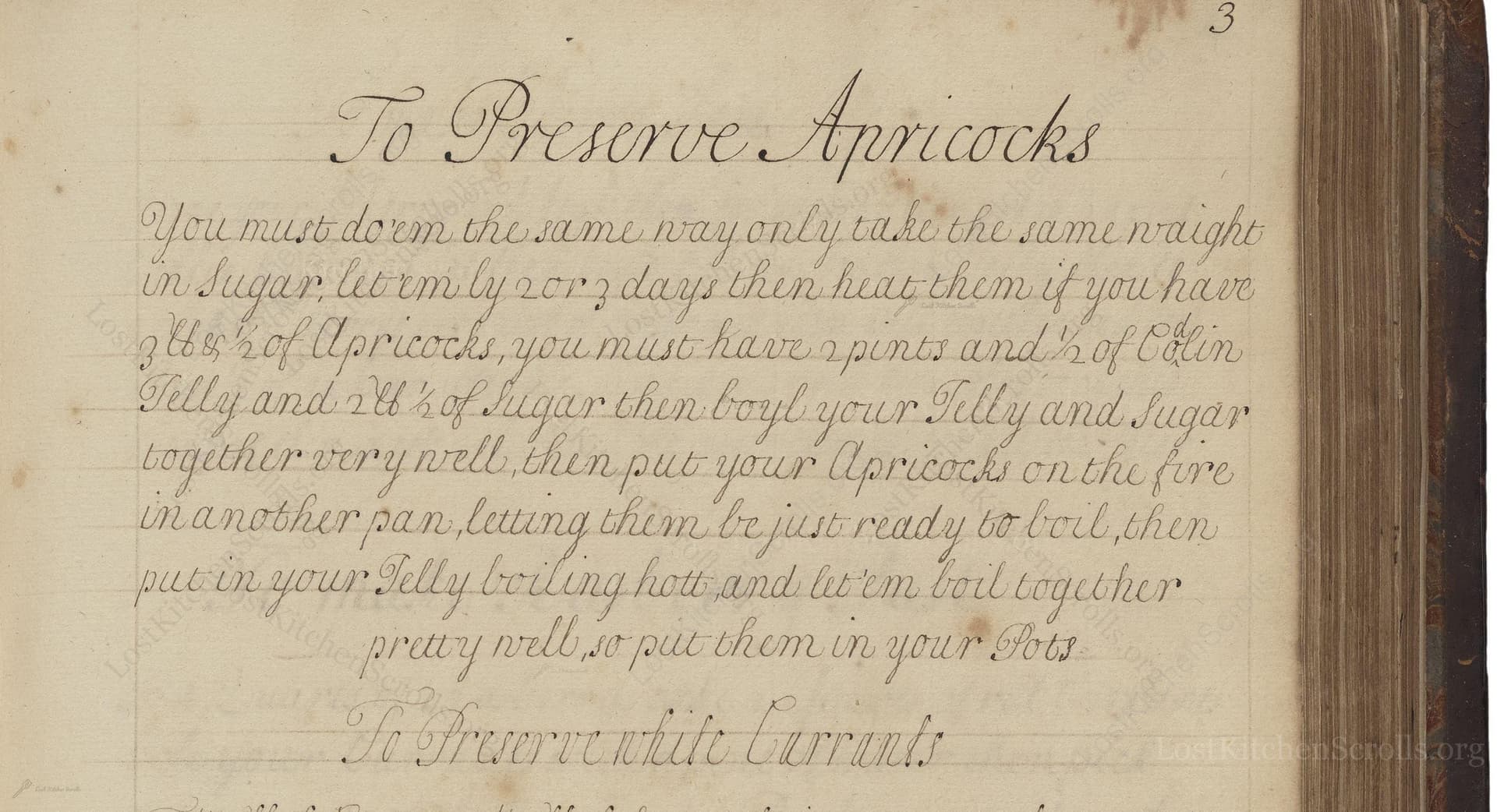To Preserve Apricocks
From the treasured pages of Cookery and medicinal recipes of M.W.
Unknown Author

To Preserve Apricocks
"You must do em the same way only take the same waight in Sugar, let em ly 2 or 3 days then heat them if you have 3lb & 1/2 of Apricocks, you must have 2 pints and 1/2 of Colin Jelly and 2lb & 1/2 of Sugar then boyl your Jelly and Sugar together very well, then put your Apricocks on the fire in another pan, letting them be just ready to boil, then put in your Jelly boiling hott, and turn em boil together pretty well, so put them in your Pots"
Note on the Original Text
This recipe is written in the brief, elliptical style typical of 18th-century English cookery manuscripts, assuming the reader's basic familiarity with preserving techniques. Terms like 'ly', 'boyl', and 'waight' are archaic spellings for 'lie', 'boil', and 'weight'. Directions rely on the cook's intuition, providing broad instructions rather than exact timings or temperatures. This was common in a world where recipes were as much memory aids as explicit guides.

Title
Cookery and medicinal recipes of M.W. (1775)
You can also click the book image above to peruse the original tome
Writer
Unknown
Era
1775
Publisher
Unknown
Background
A delightful glimpse into British kitchens of yesteryear, this manuscript collection—attributed simply to 'M. W.'—whisks readers through cherished recipes and culinary wisdom passed down between 1700 and 1850. A treasure trove for those who savor the artistry of historical cookery.
Kindly made available by
Folger Shakespeare Library
This recipe is drawn from an early modern English household manuscript, attributed to 'M. W.' and dated between 1700 and 1850. In this era, preserving fruit was a valued domestic skill, essential both for pleasure and necessity, before reliable refrigeration existed. Ingredients such as 'Colin Jelly'—likely a firm, pectin-rich fruit jelly like apple or quince—were widely used as a setting agent for preserves. Such recipes were recorded and passed down in family manuscripts, reflecting the household's resourcefulness and the period's taste for sweet preserved fruits.

The original method would have called for large, heavy copper or brass preserving pans set over a hearth or open fire. A wooden spoon or spatula would have been used for stirring, and the fruit would have been stored in glazed ceramic or glass pots, sealed with paper or waxed covers. Strainers or muslin cloths might be used to clarify jellies, and scales (balance scales with weights) would ensure accurate measurements.
Prep Time
P2DT15M
Cook Time
30 mins
Servings
8
We've done our best to adapt this historical recipe for modern kitchens, but some details may still need refinement. We warmly welcome feedback from fellow cooks and culinary historians — your insights support the entire community!
Ingredients
- 3½ lbs fresh apricots (halved or sliced, stones removed)
- 2½ lbs granulated sugar
- 2½ pints fruit jelly (apple jelly or quince jelly as a modern substitute for 'Colin Jelly')
Instructions
- To make preserved apricots in the spirit of the early 18th century, begin by weighing your fresh apricots and using an equal amount of sugar (by weight).
- Lay the halved or sliced apricots with the sugar in a bowl, cover, and let them macerate for 2 to 3 days in the refrigerator to draw out their juices.
- Meanwhile, prepare a pectin-rich fruit jelly (in place of 'Colin Jelly', you may use apple or quince jelly as a substitute).
- For 3½ lbs apricots, use 2½ lbs sugar, and 2½ pints of fruit jelly.
- Boil the jelly and sugar together until the sugar dissolves entirely and the mixture gently thickens.
- In a separate saucepan, heat the apricots gently until just about to boil.
- Pour the boiling hot sugar-jelly syrup over the apricots, return to the heat, and boil together briefly until the fruit is translucent and tender.
- Store in sterilised jars.
Estimated Calories
210 per serving
Cooking Estimates
You will need to spend a few minutes preparing and slicing the apricots, and then let them soak with sugar in the fridge for 2 to 3 days. The actual cooking time is quite short, just long enough to dissolve the sugar and syrup, gently cook the apricots, and finish the preserve. This recipe makes about 8 jars, and each serving has around 210 calories.
As noted above, we have made our best effort to translate and adapt this historical recipe for modern kitchens, taking into account ingredients nowadays, cooking techniques, measurements, and so on. However, historical recipes often contain assumptions that require interpretation.
We'd love for anyone to help improve these adaptations. Community contributions are highly welcome. If you have suggestions, corrections, or cooking tips based on your experience with this recipe, please share them below.
Join the Discussion
Rate This Recipe
Dietary Preference
Main Ingredients
Culinary Technique

Den Bockfisch In Einer Fleisch Suppen Zu Kochen
This recipe hails from a German manuscript cookbook compiled in 1696, a time whe...

Die Grieß Nudlen Zumachen
This recipe comes from a rather mysterious manuscript cookbook, penned anonymous...

Ein Boudain
This recipe comes from an anonymous German-language manuscript cookbook from 169...

Ein Gesaltzen Citroni
This recipe, dating from 1696, comes from an extensive anonymous German cookbook...
Browse our complete collection of time-honored recipes



